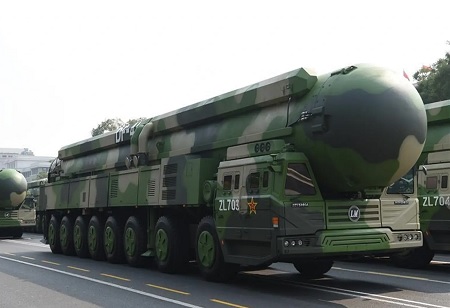
China's PLA Conducts First Public Test Launch of ICBM into Pacific Ocean

 China has publicly confirmed for the first time that it successfully launched an intercontinental ballistic missile (ICBM) into the Pacific Ocean, a development likely to heighten international worries regarding the country’s nuclear expansion. The missile, which carried a dummy warhead, was launched by the People’s Liberation Army Rocket Force in Beijing and landed in designated sea areas, according to a statement from the Chinese defense ministry. They emphasized that the launch was a routine part of their annual training schedule and was not aimed at any specific country or target.
China has publicly confirmed for the first time that it successfully launched an intercontinental ballistic missile (ICBM) into the Pacific Ocean, a development likely to heighten international worries regarding the country’s nuclear expansion. The missile, which carried a dummy warhead, was launched by the People’s Liberation Army Rocket Force in Beijing and landed in designated sea areas, according to a statement from the Chinese defense ministry. They emphasized that the launch was a routine part of their annual training schedule and was not aimed at any specific country or target.
"China informed the countries concerned in advance”, according to a separate Xinhua report, which did not clarify the path of the missile or where exactly in the high seas of the Pacific Ocean it fell. "The launch effectively tested the performance of weapons and equipment and the training level of the troops, and achieved the expected goal”, Xinhua reported.
The PLA Rocket Force, responsible for managing China's conventional and nuclear missiles, has been assigned the task of modernizing the nation's nuclear arsenal to counter advancements like enhanced U.S. missile defenses, improved surveillance capabilities, and strengthened alliances. However, some analysts contend that the pace of China's nuclear expansion exceeds what would be considered a credible minimum deterrent.
The Chinese military has emphasized that the Central Military Commission, headed by President Xi Jinping, is the only nuclear command authority. China, which has been frequently criticized by the U.S. for the opacity of its nuclear build-up, scrapped nuclear talks with Washington in July over U.S. arms sales to Taiwan. China has more than 500 operational nuclear warheads in its arsenal, of which approximately 350 are ICBMs, and will probably have over 1,000 warheads by 2030, the Pentagon estimated last year. China’s military is constructing hundreds of secret silos for land-based ICBMs, the Pentagon said in the report.
In comparison, the U.S. has 1,770 operational warheads deployed, while Russia has 1,710. The Pentagon indicated that by 2030, a significant portion of Beijing’s arsenal is expected to be maintained at higher readiness levels. Meanwhile, Taiwan, a democratically governed region that China asserts as its territory, has reported a rise in Chinese military activities in the vicinity of the island over the past five years.
Taiwan's defense ministry reported the detection of 23 Chinese military aircraft, including J-16 fighters and drones, conducting long-range missions to the southeast and east of the island. The ministry also noted an increase in “intensive” Chinese missile launches and other drills, although it did not specify the locations of these activities. In response, Taiwan has deployed its own air and naval forces to monitor the situation, according to the ministry.

